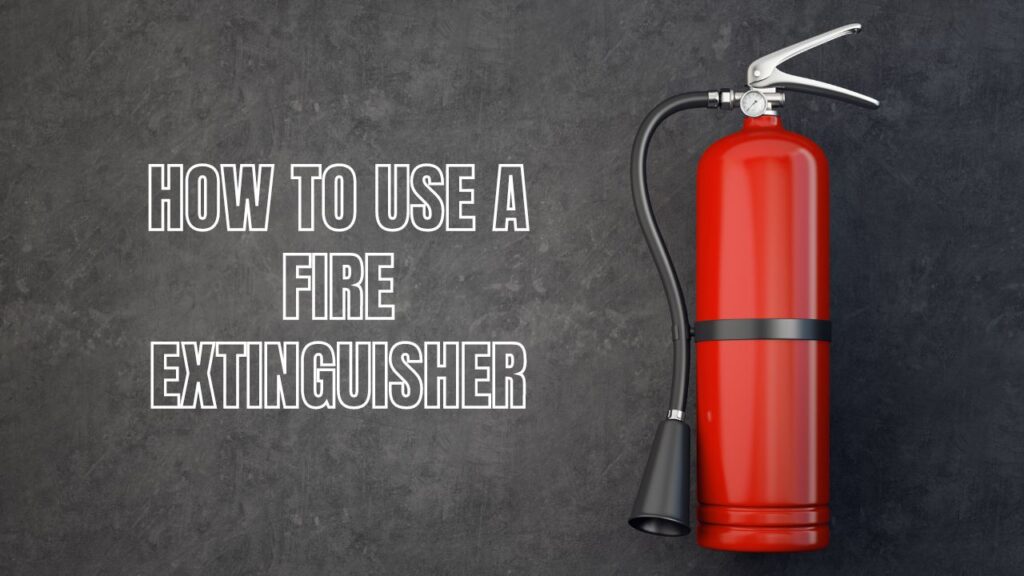Using a fire extinguisher properly can prevent small fires from turning into devastating disasters. The easiest way to remember how to use one is by following the PASS method: Pull, Aim, Squeeze, and Sweep.
To use a fire extinguisher:
- Pull the pin to break the tamper seal.
- Aim the nozzle at the base of the fire.
- Squeeze the handle to release the extinguishing agent.
- Sweep the nozzle side to side until the fire is completely out.
Fire extinguishers are the first line of defense against small fires in homes, offices, and public places. Knowing how to use one correctly can mean the difference between a minor incident and a catastrophic fire. Many people have extinguishers but hesitate in an emergency because they are unsure how to operate them. By learning and practicing the PASS method, we can respond confidently in an emergency.
Key Takeaways:
- Fire extinguishers can stop small fires before they spread.
- The PASS method (Pull, Aim, Squeeze, Sweep) is the easiest way to remember how to use one.
- Always check the fire class and extinguisher type before use.
- Maintain a safe evacuation path in case the fire grows out of control.
- Fire extinguishers should be inspected regularly for proper functionality.

Understanding Fire Extinguishers
Types of Fire Extinguishers
Fire extinguishers are classified based on the type of fire they can put out. Using the wrong one can be ineffective or even dangerous.
| Class | Type of Fire | Common Sources | Extinguisher Agent |
|---|---|---|---|
| A | Ordinary Combustibles | Paper, wood, cloth | Water, foam |
| B | Flammable Liquids | Gasoline, oil, paint | CO2, foam, dry chemical |
| C | Electrical Fires | Appliances, wiring | CO2, dry chemical |
| D | Flammable Metals | Magnesium, titanium | Dry powder |
| K | Cooking Fires | Grease, oil | Wet chemical |
Choosing the Right Fire Extinguisher
Before attempting to put out a fire, ensure you have the correct extinguisher. Using water on an electrical or grease fire can make things worse. Most households benefit from an ABC extinguisher, which covers common fires.
Step-by-Step Guide: Using a Fire Extinguisher
Step 1: Pull the Pin
The pin prevents accidental discharge. Pulling it breaks the seal and makes the extinguisher ready to use.
Step 2: Aim at the Base of the Fire
Point the nozzle low, at the source of the flames, not at the smoke or top of the fire. This ensures the extinguishing agent reaches the burning material.
Step 3: Squeeze the Handle
Pressing the handle releases the extinguishing agent. Be prepared for some force, especially with CO2 extinguishers.
Step 4: Sweep Side to Side
Move the nozzle side to side, covering the entire fire base. Keep spraying until the flames are completely out.
Bonus Tip: Stay Alert
Even after the fire appears to be out, stay back and watch for reignition. If the fire grows or spreads, evacuate immediately and call 911.
Additional Fire Safety Tips
Fire Extinguisher Maintenance
Regular maintenance ensures your extinguisher will work when needed.
- Inspect monthly: Check the pressure gauge and overall condition.
- Shake dry chemical extinguishers: Prevent the powder from settling.
- Recharge after use: Even if only partially discharged.
- Replace expired extinguishers: Check the manufacturer’s guidelines.
When Not to Use a Fire Extinguisher
Fire extinguishers are for small, manageable fires. Evacuate and call for help if:
- The fire is spreading rapidly.
- The flames are higher than your head.
- The air is filled with toxic smoke.
- You don’t have a clear exit path.
Fire Prevention Best Practices
- Keep flammable materials away from heat sources.
- Install smoke detectors and check batteries regularly.
- Never leave cooking unattended.
- Store flammable liquids properly.
FAQs
What should I do if a fire extinguisher doesn’t work?
If the extinguisher fails, immediately evacuate and call 911.
Can I reuse a fire extinguisher after spraying it?
Most extinguishers need recharging after any use, even a small discharge.
How often should I check my fire extinguisher?
Inspect monthly and get a professional check annually.
Can a fire extinguisher explode?
If stored improperly or exposed to extreme heat, it can rupture. Keep it in a cool, dry place.
Is it safe to use a fire extinguisher indoors?
Yes, but ensure proper ventilation, especially with CO2 extinguishers.
Be Ready, Stay Safe
Fires are unpredictable, but preparation makes all the difference. Knowing how to use a fire extinguisher can save lives and property. Practice the PASS method, choose the right extinguisher, and always prioritize safety. If in doubt, evacuate and call for help.
Stay safe, stay prepared! Callaway Security™™ offers fire alarm services to add more protection to you and your property. Contact us today!










